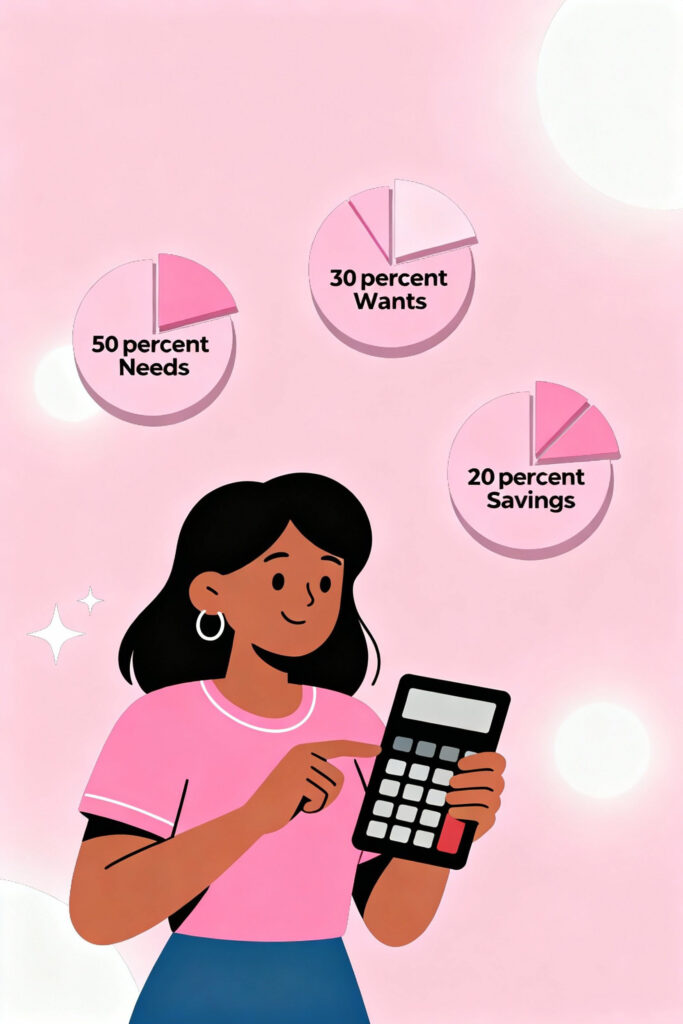Budgeting may sound like an overwhelming or intimidating task, but in reality, it’s one of the easiest and most empowering things you can do for yourself and your money. The 50/30/20 budget is one of the simplest and most effective methods to organize your income, giving each dollar a meaning and purpose to serve, without making you feel restricted or deprived. Whether you’re just starting out with budgeting or trying to get back on track, the 50/30/20 rule can be your go to for making money management more structured and less stressful. This article will help you explore the dynamics of the 50/30/20 budgeting method, allowing you to understand it and use it to control your money rather than letting it control you.
What Is the 50/30/20 Budget Rule?

The 50/30/20 rule is a simple budgeting guideline that helps you manage your monthly income. This rule suggests that 50% of your income is spent on needs, 30% on wants, and 20% on savings or debt repayment.
This structure ensures that your essential expenses are covered, lifestyle is balanced, and savings is given a room alongside your other expenses, ensuring structure and balance. It’s a flexible system that adapts to different income levels, making it especially helpful for beginners who want an easy way to manage their money without complex spreadsheets or strict rules.
Understanding the 50% for Needs Category

According to this rule, 50% of your paycheck goes to your needs or those essential expenses, including rent, groceries, housing, utilities, or transportations. If you feel like your needs are taking up more than half of your income, it might be a considerable option to look for ways to lower some of those costs, like moving to an affordable place or cutting off unnecessary services.
Keeping your basic needs within this 50% spending limit can help you avoid financial stress and ensures that an enough portion of your income is left behind for wants and savings category.
Breaking Down the 30% for Wants Category
According to this rule, 30% of your income is assigned to your wants or those nice-to-have items including shopping for clothes, takeouts, or subscriptions you barely use. This 30% is meant to give you the freedom to spend on things you like without any shame or guilt. It’s more of a guilt-free spending category that makes you happy while also prioritizing other important expenses.
While this category allows you to spend on things you find fun and enjoyable, it is important to spend this money mindfully and intentionally, not on impulse purchases but on experiences or items that add value to your life.
The Importance of 20% for Savings and Debt RepayAment
Lastly, 20% of your income goes to savings, investment or debt repayment, if there is any. You can use this portion of the 50/30/20 rule to save for a big future purchase, an investment, or something as simple as building an emergency fund.
This portion of your budget perfectly secures your future, saving you from those unforeseen future circumstances that can cost a fortune or those unexpected expenses that can put your entire budget off track. Even if you start with setting a small amount aside, what matters the most is your willingness and consistency to set something aside, serving the future you in the best way possible.
How to Calculate Your 50/30/20 Budget
To apply this rule, what you need to start with is to calculate what your monthly take-home income is, the amount after all the taxes and deductions. Once you have a specific figure, calculate what 50%, 30%, and 20% of that figure comes out to be. For example, if you earn $3,000 per month, you’d spend $1,500 on needs, $900 on wants, and $600 on savings or debt repayments.
Having a clear figure and its clear division can make the whole process feel a lot easier, allowing you to plan your expenses considering the amount, keeping you from overspending on one area.
Tracking Your Spending Habits
Before you can start with the budgeting method, it is important to understand and track your expenses for at least one month. Whether it’s a grocery bill, an online order, or a coffee run, you can use an app, create a spreadsheet, or use something as simple as a notebook to track what you spend on.
This step can help you see your spending patterns clearly, allowing you to make changes or modifications to your unhealthy spending patterns. Once you’re done tracking your habits, it might surprise you how much you spend on those small and seemingly harmless expenses that cost you way more than you realize, eating away a huge chunk of your budget.
Adjusting the Rule to Fit Your Lifestyle
The 50/30/20 rule is just a financial guideline and not something strict that you’re supposed to follow. Everyone’s financial situation is different which is exactly why it is okay to make modifications to the rule as per your convenience. If you feel like your needs cost way more and 50% is a bit less for them, you can follow a 60/20/20 ratio for the three categories.
What matters the most is to make sure you’re still saving each month, even if it’s a small amount.
Automating Your Finances
One of the easiest ways to stay consistent with the 50/30/20 rule is to automate your finances. A smart approach would be to set up automatic transfers from your checking account to your savings account right after you receive your paycheck. This way you allow your savings to grow in peace without any drama or distractions.
Automation of transfers also takes away the effort of moving money, relying less on willpower and more on consistency. Moreover, it also takes away the temptation to spend that money elsewhere and helps you build discipline effortlessly.
Reducing Overspending in the Wants Category
It can be very easy to let your “wants” category get out of control, especially when small purchases feel harmless at the moment. A coffee here, a new shirt there, and before you know it, those little spends add up quickly and eat into your savings portion.
The key to reducing overspending in this category is to be more mindful of what truly brings you joy and what’s just an impulse purchase. Before buying something, pause for a while and ask yourself if you really need it or if it will lose its charm in a few days. You can even make a list of your favorite “wants” and set a small limit each month so you can enjoy spending without guilt or stress.
Building an Emergency Fund with the 20% Portion
An emergency fund is one of the most powerful forms of financial security you can give yourself. Using the 20% savings portion of your budget, you can slowly build a small safety net that protects you from unexpected expenses like medical bills, car repairs, or job loss. You don’t have to start big, even saving a small portion of that 20% each month can make a huge difference over time.
The goal is to build at least three to six months’ worth of living expenses, which gives you peace of mind and financial stability during uncertain times.
Using the 50/30/20 Rule for Long-Term Goals
The beauty of the 50/30/20 rule is that it not only helps with your daily budgeting but also supports your long-term financial goals. The 20% category can be divided into different purposes, such as saving for retirement, buying a home, or investing in your education. Having a clear idea of what you’re saving for gives your money a sense of direction and purpose.
You can even set up separate savings accounts for each goal, so you can track your progress more easily.
Reviewing and Adjusting Your Budget Regularly
Budgeting isn’t something you set once and forget, it’s a living plan that changes as your life and priorities evolve. Reviewing your 50/30/20 budget regularly, ideally once every few months, can help you identify what’s working and what isn’t.
By reviewing your budget, you ensure that your financial plan still fits your current lifestyle and goals. This habit also keeps you aware of where your money is going and prevents you from slipping back into unhealthy spending habits.
Conclusion
The 50/30/20 budget rule is one of the simplest yet most effective methods to take control of your finances without feeling restricted or overwhelmed. It gives structure to your income while allowing you the flexibility to enjoy life, save for the future, and meet your needs with balance. Whether you’re trying to pay off debt, save for a big purchase, or simply manage your money better, this rule can be easily tailored to fit your lifestyle. What truly matters is consistency and mindfulness, small steps taken regularly can create big changes over time. With this budgeting method, you’re not just managing your money, you’re building a stronger and more secure financial future for yourself.
